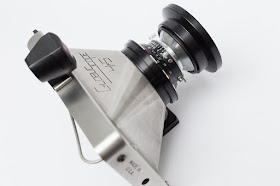While I can't do them justice here, I will tell you this: they are absolute pioneers in the photographic world.
Any photo-geek worth their weight in D-76 should spend a little time reading about their contributions to the photographic world that range from developing several notable cameras to one of the brothers contributions to fixing the damaged Hubble Space Telescope.
Long being a fan of the 4x5 Globuscope as well as the look and
feel of the 65mm f/8 Super Angulon, the Globuscope 4x5 has been the
subject of many of my post conscious-family, nocturnal subterranean searches.
After a couple years of seeing camera bodies come and go, internet lore
will have us believe that 40 or so stainless camera bodies were discovered in
the Globus studio in NY. Regardless of the validity of claim, I was
excited that a camera body might soon emerge in my price range.
After some back and forth with a seller with two camera bodies,
we struck a deal for Globuscope 4x5 #74, just about smack dab in the
middle of 150 cameras that were made. Oddly enough, and for you mathematicians out there, I am
aware of the peculiar claim of #74 being one of the 40 recently discovered out of 150 made. I would have thought #110-150 or #1-40 would show back up, but who knows... Moving forward, I promise not to have as much coffee as I've had while having my
'happy light' on high mode for well over the recommended hour of AM
exposure....but I digress (again...)
How do you take a stamped stainless frame and make it into a fully functioning camera that is ready for
the field? This post is how #74 came back to life. Before starting, I gave myself a couple of ground-rules, I wanted to
respect the initial design of the camera, to me, this meant no cutting
and drilling. Everything should be reversible.
The first order of business was getting a lens mounted and
focusing. Searches of the web show lots of different of solutions here
ranging from functional to downright absurd. Digging through my
boxes of parts, I located the second generation Schneider helical that was
inscribed for the 65mm. Score! In addition it was a perfect fit
for the stainless steel opening. Some of the cameras that I've
seen still have the first stage of the Globus focusing mechanism intact.
Holding my breath, I got out a dark cloth and a tape measure and measured off 12 feet and it was tack sharp on the ground glass and infinity was infinity! Perfect. I had the option of pulling a
set screw from the helical or filing a very small slot into the camera which will
keep the helical from spinning if it ever became loose. I did file
the slot and added a very thin bead of gaffers tape so the helical wasn't mounting
metal to metal. The second version of the helical is lighter,
focuses easier and is inscribed in both english and metric
on opposite sides. Depending on which measuring system you would like to
use was which way you oriented the mount.
I do wish I could have found a Linhof Technika select version of
the lens as that is (in theory) the very best 65mm f/8 available, but the 65mm I found tested beautifully. From an earlier camera I built, I knew I wanted to finish the lens with
the Nikon HK-6 metal shade which was made for the Nikon 20mm f/3.5. The
diamater of the Super Angulon to is too small for the shade to mount securely so I cut the center out of a push-on lens cap to serve as a shim. If
you leave the bead from the Schneider lens cap on and reverse it as you slide
it over the lens, the shade fits PERFECTLY with a nice little trim bead behind
the shade.
Tripod mount:
 |
| both the arca plate and lens shade shim are visible |
Finder and finishing touches:
I went back and forth between a black or chrome circular bubble
level, I was leaning towards a black anodized level, but my
family vetoed, and I went with a chrome level from Geier & Bluhm out of New York. Great suppliers of levels of all kind for just about any camera project you can dream up. Again, I used white
adhesive caulk to adhere it to the top plate. Lastly,
short of a Zeiss finder, the very best finders (at any price) are made
by Voigtlander. A black Voigtlander 21mm optical finder was calked
onto the existing accessory shoe.
That just about completes what I did to breath some light back into this beauty and here is the bitter sweet part: I placed the camera on several forums and eBay and went off to load some holders to take it out for a spin. Before I knew it, the camera sold. And while I knew all along that I couldn't afford to keep it, I was surprised it sold so fast...until I saw who bought it and where it went.
That just about completes what I did to breath some light back into this beauty and here is the bitter sweet part: I placed the camera on several forums and eBay and went off to load some holders to take it out for a spin. Before I knew it, the camera sold. And while I knew all along that I couldn't afford to keep it, I was surprised it sold so fast...until I saw who bought it and where it went.












